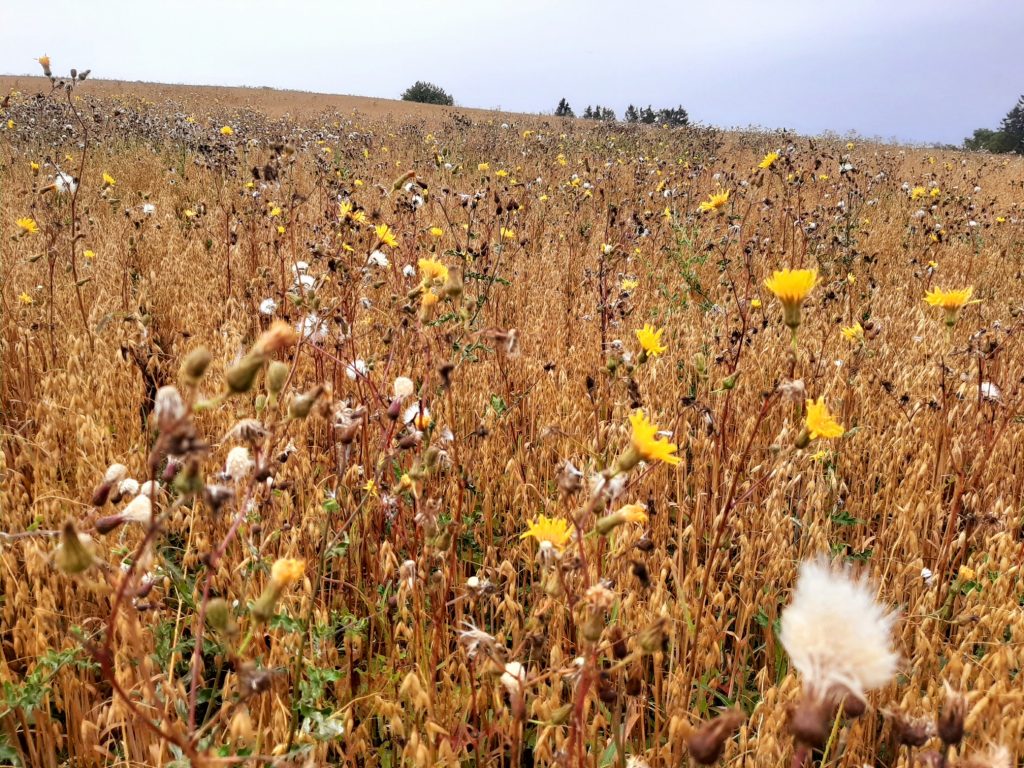Sonchus arvensis (common name: perennial sow thistle, field sow thistle) is a perennial weed and one of the major concerns in many cropping systems (1). It is native to Europe and Asia and is introduced to North America. In northern Europe, it is especially problematic in arable crops and to some extents in grasslands. This species propagates vegetatively by creeping thickened roots, and generatively by an abundant seed production. Clonal spread may vary from 0.5 to 2.8 m per year, and seeds may be spread by wind for up to 10 m (2).
The growth of root fragments planted in the previous autumn or coming spring may give 1.5-2.2 m to 10-15 m long thickened roots (3). The creeping roots are located 5-12 cm below soil, and produce aerial shoots and long vertical roots from adventitious buds (1, 4, 5). These roots are subject to mechanical disturbance by tillage. Although the roots’ viability can be decreased by cutting through tillage, the root fragments that are at least 2.5 cm long can still produce new plants. The creeping roots can survive through winter to the next spring (6). However, in the Nordic countries, they have restricted sprouting ability due to internal factors (e.g., innate dormancy, endodormancy) from July/August to November (1, 4, 5).
As S. arvensis falls into dormancy early in autumn, the autumn tillage is less effective for this species. This species is also sensitive to light and crop competition (6). Management of this weed by only one method is often not enough, therefore a combination of direct control measures is needed. Competition as an important integrated control method, should also be considered for this perennial species (7).

Photo by: Marian-Malte Weigel 
Photo by: Sabine Andert 
Photo by: Kirsten Tørresen
- Brandsæter, L.O., Fogelfors, H., Fykse, H., Graglia, E., Jensen, R.K., Melander, B., Salonen, J. and Vanhala, P., 2010. Seasonal restrictions of bud growth on roots of Cirsium arvense and Sonchus arvensis and rhizomes of Elymus repens. Weed Research, 50(2), pp.102-109.
- Lemna, W.K., Messersmith, C.G. (1990): The biology of Canadian weeds. 94. Sonchus arvensis L. Canadian Journal of Plant Science 79, 509-532.
- Tørresen, K.S., Fykse, H., Rafoss, T. (2010): Autumn growth of Elytrigia repens, Cirsium arvense and Sonchus arvensis at high latitudes in an outdoor pot experiment. Weed Research 50, 353- 363. doi:10.1111/j.1365-3180.2010.00791.x
.
- Andersson, L., Boström, U., and 4 co-authors (2013): Sprouting capacity from intact root systems of Cirsium arvense and Sonchus arvensis decrease in autumn. Weed Research 53, 183-191. doi:10.1111/wre.12013
.
- Liew, J., Andersson, L., and 4 co-authors (2013): Regeneration capacity from buds on roots and rhizomes in five herbaceous perennials as affected by time of fragmentation. Plant Ecology 214, 1199-1209. doi:10.1007/s11258-013-0244-4
.
- Vanhala, P., Lötjönen, T., Hurme, T., Salonen, J. (2006): Managing Sonchus arvensis using mechanical and cultural methods. Agricultural and Food Science 15, 444-458.
- CABI, 2019. Invasive Species Compendium. Wallingford, UK: CAB International. www.cabi.org/isc.




